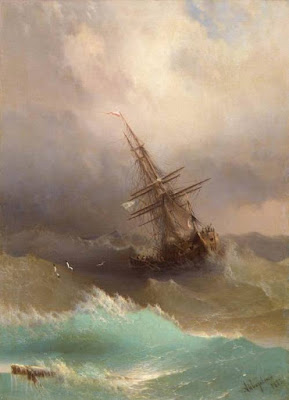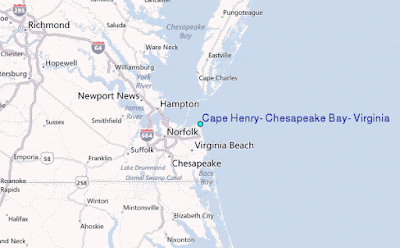 |
| SHIP IN THE STORMY SEA, by Ivan Aivazovsky, 1887 in the public domain |
This is more of a community history post than a profile post, but my ancestors were part of that community, and it is a wonderful story. They are not name-players in this story, and I will later do separate posts on each of them, but a surviving partial passenger list for the James Beacham/Famous Dove includes my fourth great-grandfather, Johan Adam Essinger, and information received from a new cousin may place some of my Schneiders on this trip. I am posting the story now, so that my family (and maternal side cousins), the descendants of the shipwreck survivors, may recognize and honor the importance of September 17 in the fact that we exist.
My ancestors came from the southern part of Germany, in the Grand Duchy of Hesse Darmstadt. They lived in small villages in the wooded hills of the Odenwald, just east of the Rhine River. The Essingers came from Reichenbach and the Schneiders came from the Gadernheim; others on this journey also came those villages and from the villages of Lautern and Raidelbach. They all attended a small Lutheran Church on a hill in the village of Reichenbach. Most of the members of the church were farmers, some were smiths, and at least one owned and operated the local mill.
 |
| Detail of the portion of Hesse that was once Hesse-Darmstadt, and home to those who emigrated to NW Ohio on the Famous Dove Used with permission of R.M. (Click to make bigger) |
First, a little bit about the history of Hesse-Darmstadt to understand the home of the people who eventually left it to move to northwestern Ohio. In 1806, with the dissolution of the Holy Roman Empire, Hesse-Darmstadt became part of Napoleon’s Confederation of the Rhine and became a Grand Duchy (had been a Landgraviate, a German principality headed by a Landgrave). Hesse-Darmstadt troops served with the French from 1806-1813, and then Hesse-Darmstadt joined the allies in 1813 and fought on the side of the Coalition against France, succeeding in pushing France out of Germany in 1814. Between 1813 and 1815 citizens and laborers supported the wars of liberation against the Napoleonic foreign rule, giving rise to a new German patriotism. On 30 May 1814, the Treaty of Paris declared the German States independent. Hesse-Darmstadt entered the German Confederation in 1815.
In the aftermath of nearly a decade of war, Hesse-Darmstadt’s economy was bad, inflation was high, and the Grand Duke had imposed high taxes to fund the rebuild of the country. Additionally, forced military service required that once a boy was 16, he had to serve three years in the service. All of these conditions caused the small farmers and craftsmen to look to emigrating from Germany. Emigrating to America was a popular choice because Germans who had already gone to America were writing letters home telling of the contrast in land values between Germany and America. America was painted as a bounteous land of opportunity while in Germany the cost of land was disproportionately high, making it difficult for the small farmer to acquire enough land to feed his family, let alone to pass down land to his sons in amounts that would allow each to survive. Ironically, that same issue made it easier for the small farmer to sell his farm in Hesse at a price that would enable him and his family to cross the sea to America and buy a larger farm which could support his family.
 |
| Used with permission of R.M. (Click to make bigger) |
In the Odenwald, in Hesse-Darmstadt, two men decided to organize a group of friends and neighbors to travel to America. One was Johan Tracht; the other was Johan Peter Arras. Between the two groups, there were at least 150 friends and neighbors leaving for a new life in America in 1831. It must have been a difficult decision to leave. Most Germans in that time period, unless they had fought with the army, had never been further from home than the nearest village. Those deciding to emigrate with Tracht and Arras knew that they were unlikely to see anyone they were leaving behind ever again. Moreover, not only were they leaving their homes, they had to leave behind or sell many of their possessions to move to this new unknown land. The first leg of their trip took them through Darmstadt and Kassel to Bremen, approximately 300 miles away. They arrived at Bremen sometime in July, and on July 29 they went to Bremen’s seaport. On July 31, 1831, they loaded their possessions onto two ships. One of these ships was the British ship, the James Beacham, sailing for Baltimore. The other ship was a Dutch ship which was sailing to New York. As the English ship was newer, everyone wanted to board it. The partial passenger list surviving shows that the Essingers managed to make it onto this ship. The James Beacham has been described as 118 feet long, 28 feet wide, and 20 feet high, with two masts and 24 sails. It was large enough to carry 7800 tons of cargo. I don’t have a description of the older ship or even its name.
At this time, when immigrants reserved passage on a ship, it was understood that they had to provide their own food for the entire trip. The history of the Trinity Lutheran Church, by Jon Rossman, includes an excerpt from a letter written by Johan Peter Arras that tells what some of these provisions were: “we needed potatoes, beans, peas, barley, rice, white flour, tea, sugar, coffee, the herring are very good, eggs, cheese, sausage, vinegar, wine, white and dark Zweiback, the white is tastier than the dark. We could take bread for 15 days also meat for 14 days, you salted some, or else it would sour and could not be eaten. The water was terrible. Pork kept better, it would not sour as fast.” They left port on August 1, 1831. The captain of the ship had told them that it this trip would take 32 days. During the course of the trip, the immigrants renamed the ship, the “Famous Dove” as a symbol of their hope and freedom.
However, there were some problems on the trip: they did not have any wind for 12 days and there were also a few days when the wind blew in the wrong direction; they were also hit by a couple of storms at sea. It also became apparent that the captain was inexperienced and often drunk. Also while they were at sea, two of the families lost a child (not my families). However, that wasn’t the worst part of the trip.
On their last day at sea, September 16, 1831, a strong gale came up near America and they were blown off course, losing both the mast and the rudder, and waves were washing the decks. Off the coast of Virginia, east of Norfolk, just south of Cape Henry, the ship hit a sandbar which tore a large hole in the bottom of the ship. The ship quickly filled up with water. When the captain realized what was happening he ordered his crew to launch a lifeboat so they could escape, without the passengers. When the immigrants realized what was going on, one of the leaders, Johan Tracht, took seven guns he had brought to hunt with out of his trunk and armed himself and six other men. He gave orders to shoot anyone who attempted to abandon ship and thus persuaded the crew to stay aboard. Subsequently, in order to stop the ship from being tossed about by the storm, the brother of the other leader, Arras, ordered the men to cut down the mast so that the wind would not be able to catch in the sails and bounce the ship about on the waves. This helped, but the storm continued and the ship was quickly filling up with water and appeared that it would sink within a few hours. The people were afraid. The story then says that the 13-year-old Margaret Arras reminded the people of how Jesus quieted the waters of the sea of Galilee and saved his disciples; she said he would save them also. One of the sailors wanted to slap her for talking foolishly, but then she started to sing a hymn. All of the immigrants joined her in the singing and praying, and even some of the sailors. They vowed, “if we are saved, the 17th of each September shall be kept as a holy day by us and by our descendants, even unto the third and fourth generation.”
 |
| Map of the coastline of Virginia, focusing on the Cape Henry area (Click to make bigger) |
When morning came, the storm had stopped and when they looked out towards the West they discovered that they were only 100 yards from land, and people had gathered on land to help rescue them, including a number of the first black people they had ever seen. Lines were run to the wrecked ship and the opposite end fastened to trees on the shoreline, and the immigrants then made the trip to shore in small boats pulled along the cables. Families left the ship first and then the single men. Even though all of the people were saved, many of them lost some or all their possessions. When they were all safe on shore, they gathered and thanked God for saving them from the storm. I found the wreck reported in papers as far away as Washington DC and Yorkshire, England.
 |
| The James Beacham Shipwreck, 16 Sep 1831, as reported in The Washington National Intelligencer 23 Sep 1831 p3 Click to make bigger |
They initially set up camp in the Norfolk area as they needed some time to recover and plan. They still had a long way to go before they reach their planned new home in Ohio. They stayed in Norfolk until September 21, then they went to New York by boat and arrived on September 22. They stayed in New York one day and left for Baltimore on a steamship at on the 23rd. At that point, since they had lost many of their possessions, the people split up and decided that each family would have to earn its own way to Ohio. For a while, a number of the families settled in Maryland and in Washington County, PA, to earn the money to continue their journey. They were moving to undeveloped frontier lands so they would have to bring everything that they thought they would need to survive. The first settlers from the Famous Dove arrived in Hancock County, Ohio, in 1834; It took approximately seven years for all of the families, except two, to arrive.
The other ship carrying the rest of the community, being older, traveled more slowly, and missed being caught in the gale. It arrived at its port intact, with its passengers and cargo safe.
-------
http://en.geschichte-abitur.de/restoration-and-vormarz/napoleons-supremacy; https://en.wikipedia.org/wiki/History_of_Hesse;
https://en.wikipedia.org/wiki/Confederation_of_the_Rhine;
“GERMANY AND THE EMIGRATION 1816-1885” by Mack Walker (1964, by the President
and Fellows of Harvard College}, http://www.mrhalliday.com/gbhalliday/Genealogywebpg/Hommerding/GermanyEmigration1816-1885%20.pdf;
“Schiffbruchsgottesdienst Trinity Lutheran Church, Jenera, Ohio: the church
with a 152 year vow” by Jon Rossman (1983), http://essays.wls.wels.net/bitstream/handle/123456789/4036/RossmanTrinityJeneraOH.pdf?sequence=1;
“Historic Hancock County, an illustrated history” by
Paulette Weiser (2007, a publication of the Findlay Hancock County Chamber of
Commerce, historical publishing network, San Antonio Texas); Shipwreck
Festival, http://www.stpaulevlutheran.org/about-us/shipwreck; http://www.stpaulevlutheran.org/; “My Genealogy Home Page: Information about Nicholas
Price”, http://www.genealogy.com/ftm/b/o/w/Brian-E-Bowers-VA/WEBSITE-0001/UHP-0052.html; Neuendetteslau Nostalgia, http://www.stjohnsmarysville.org/story;
Lutheran Forum, “Lutherans in Peril on the Sea”, https://www.lutheranforum.com/blog/2017/8/3/lutherans-in-peril-on-the-sea;
German History in Hancock County, http://downtownfindlay.com/about/oktoberfest/about-oktoberfest/